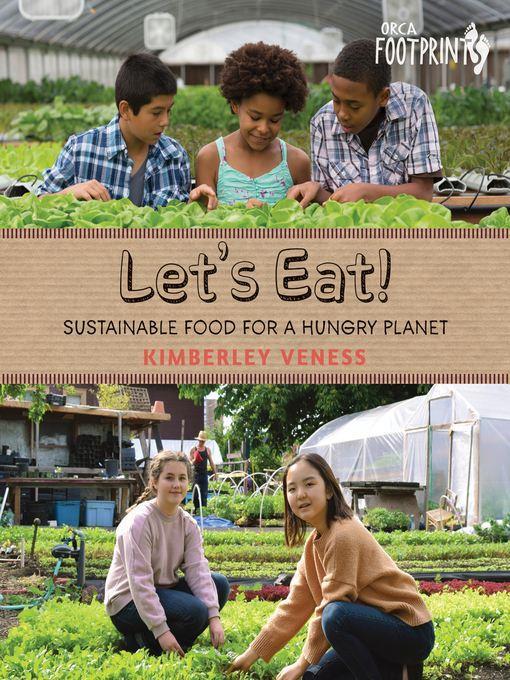
Let's Eat
Sustainable Food for a Hungry Planet
فرمت کتاب
ebook
تاریخ انتشار
2017
Lexile Score
1210
Reading Level
9-12
نویسنده
Kimberley Venessناشر
Orca Book Publishersشابک
9781459809413
کتاب های مرتبط
- اطلاعات
- نقد و بررسی
- دیدگاه کاربران
نقد و بررسی

January 1, 2017
Grades 4-7 Veness, who grew up on a farm, offers an introductory book discussing current food issues as well as how agriculture has changed over time. Chapters focus on topics such as small-scale farming, food grown in cities, and farms of the future. The frequent Farm to Table features often showcase the experiences of the author, her family, and people she's met, while Chew on This sidebars include activities, suggestions, and ideas to ponder. Farming Fact boxes carry agriculture-related statistics and factoids. Terms such as aquaculture, monoculture, tilling, and entomophagy are usually defined in the glossary if not explained in the text. Written at a higher reading level than the publisher's suggested grades would indicate, the text will be challenging for some students. Still, the many clear, color photos and the author's sometimes conversational tone make the book more inviting, and the relative lack of information on this topic for middle-graders is another consideration for libraries.(Reprinted with permission of Booklist, copyright 2017, American Library Association.)

January 30, 2017
In an engaging addition to the Orca Footprints series, newcomer Veness examines agricultural practices around the world, discussing where food found at grocery stores comes from, environmentally sound methods of farming, and sustainability. She also makes the narrative personal, weaving in memories of growing up on a farm in Saskatchewan, as well as other anecdotes: “Sometimes my brothers and sisters and I would walk around our acreage with our dad, tracking smaller game like wild rabbit and pheasant, and scanning the sky for Canada goose.” Bright photographs of crops, foods, farmers, and global farms, both urban and rural, are included throughout the book’s four chapters. Veness avoids taking an overly dour tone when looking at negative aspects of the meat and agricultural industries (“Water contamination is a real problem, but, thankfully, environmental groups and committed citizens work hard to protect these fragile ecosystems”) and instead urges readers to take stock of how integrally connected this planet is while empowering them to think critically about the food they eat and where it comes from. Ages 9–12.

January 1, 2017
Gr 3-6-Written in a friendly style, this title examines the origins, the potential hazards, and the environmental effects of the food we produce and eat. The topics presented range from small family farming to aquaponics (raising plants and fish together), and the book offers some historical background on food production all over the world. Unusual methods such as underground and skyscraper farming, hydroponics, and the cultivation of edible insects on Mars are also covered. Full-color photographs and sidebars keep the reading experience lively. However, the somewhat random arrangement of the subjects detracts from the overall cohesiveness of the work. Nonetheless, this is a valuable addition that provides new information to students interested in agriculture and the environmental results of present-day food manufacturing. VERDICT Useful for classroom discussions on farming, sustainable agriculture, and the ramifications of industrial farming.-Eva Elisabeth VonAncken, formerly at Trinity-Pawling School, Pawling, NY
Copyright 2017 School Library Journal, LLC Used with permission.

January 1, 2017
Stories abound at the local supermarket, but you will have to talk to the food.Ask any banana, avocado, or mandarin orange. Veness did, and their stories are engrossing. Veness grew up on a Saskatchewan, Canada, farm, so she is no stranger to the farming life. Between chores, she has nurtured a clear, expositional style of writing that is long on facts but lively enough to keep readers' attention. Take, for instance, tidbits like the skinny on "Naturally raised" beef: "The cow could still have lived in a feedlot"--also known as Concentrated Animal Feeding Operations--and it "probably ate corn, grain and animal by-products and received frequent doses of antibiotics and growth hormones." That's natural? A chicken raised in a CAFO "may spend its entire life in a cage smaller than a microwave." Veness carefully explains such practices as permaculture, no-till zones, rice-duck farming, community and urban gardens, and biomimicry: "creating technologies to mimic processes in nature." Consider "the RoboBee, a miniature robot [scientists] hope can pollinate crops if we lose the bees" to colony collapse disorder or insecticide use. Bright photos and a lively layout enhance the package. This account of the secret lives of groceries comes with a special grace note: "Did you know that digging your hands into a garden bed has been scientifically proven to increase happiness?" Readers will want to go out and get some dirt under their fingernails. (resources, index) (Nonfiction. 8-12)
COPYRIGHT(2017) Kirkus Reviews, ALL RIGHTS RESERVED.

























دیدگاه کاربران